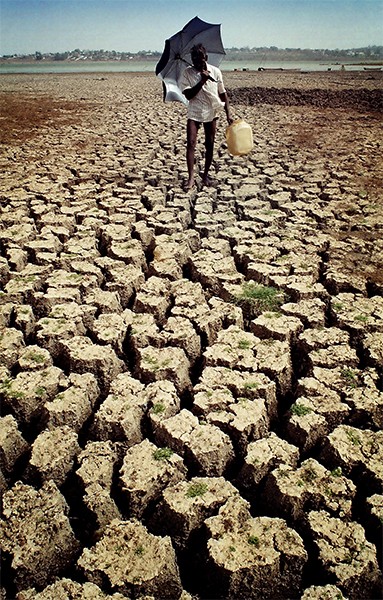Creating Resilience in the Most Vulnerable Areas

Floods ravage the countryside of Pakistan, as changing precipitation patterns exacerbate development problems. Glaciers melt in mountain ranges from Peru to Nepal, changing water availability and causing unpredictable outbursts. The low-lying atolls of the Maldives are gradually inundated as the Indian Ocean rises, increasing the impacts of storm surge. Increased sea surface temperatures in the Indian Ocean impact the monsoon cycle and precipitation patterns in east Africa. These current events are indicative of potential future situations with the extreme and unpredictable conditions wrought by climate change.
Though the direct link between climate change and a specific event or human cause is debatable, it is clear that water is a major player in its impact on development. The economic and social impacts of climate variability in developing countries underline the need to help partner countries gain the institutional capacity for resilient economic growth as climate changes.
Climate change poses a serious threat to billions of people, especially those living in the developing world, with the potential to dramatically affect living conditions, livelihoods, health and well-being on a global scale. As USAID and its partners seek viable solutions to enhance water security around the globe, it is undeniable that climate change adds yet another factor to the multi-layered set of challenges that must be analyzed and addressed to achieve development goals.
Clearly, water security and climate change are inextricably linked. Climate change is not an independent sector, a special interest, or an environmental issue. Rather, it is a fundamental, multi-sectoral, multi-disciplinary context for progress going forward with serious implications for the sustainability of every nation’s development agenda.
Development efforts for the coming century require science-based solutions that consider the following: increasingly variable future climate; taking into account water demands from multiple development priorities such as energy and agriculture; the evaluation of water resources and reservoirs above and below-ground; utilization of emerging innovative finance opportunities such as indexed insurance and payments for ecosystems services; and addressing stakeholders’ preferences and economic opportunities.
Problem assessment and project design must include a longer time horizon and apply ecosystem approaches and lessons learned from the unintended consequences of engineered waterways. Careful integration of climate adaptation and mitigation efforts into water-related programs can provide economic returns and ensure sustained benefits. For a growing number of countries, their own water security hangs in the balance of the success or failure of these efforts.
Increased sea water temperatures, ocean acidification, vulnerability to sea level rise, and saltwater intrusion to coastal aquifers are further manifestations of a changing global climate directly relevant to water security. In short, an effort to manage water resources in an integrated, holistic manner is perhaps the most critical climate adaptation strategy countries can and should be taking today.
To address these challenges, USAID is informing water resources management efforts through increased access and capacity for use of future scenarios by which program stakeholders can better understand the increasing vulnerabilities they may face and identify their own path forward. Combining traditional and proven best practices with the latest technology and research offers a multitude of solutions to addressing water concerns exacerbated by climate change.
This edition of Global Waters explores the unique and multilayered challenges that climate change brings to the water sector, and reports on USAID’s efforts to effect collaboration and cooperation among governments, NGOs, communities, scientists, and individuals to work toward long-term solutions. Here are some of the topics covered inside this issue:
The “Peaks to Coast” Program in Peru unites scientists from the Andes in Peru and the Himalayas in Nepal to share information and possible solutions to impending glacial melt on two vastly different mountain ranges thousands of miles apart.
The Soil Management Collaborative Research Support Program that USAID has co-funded and developed with the University of Hawaii demonstrates innovative farming techniques to reduce soil erosion and increase crop yields in Mali without compromising the agro-ecosystem.
As the lowest country on the planet, the Maldives presents unique challenges for water-security and climate resiliency. Our article examines this microcosm of challenges and a new USAID program to develop ‘climate resilient islands’ in partnership with the Government of the Maldives.
A collaborative effort is underway by USAID and multiple national meteorological and hydrological services and disaster management entities to support an initiative to assess flood early warning and technical, institutional, and capacity-building issues related to flood preparedness in the Zambezi River basin.
USAID’s Water Energy Nexus Activity initiative, known as WENEXA, unites India’s water and electricity sectors in a public-private partnership to simultaneously conserve energy and water resources, reduce greenhouse gases, lower costs, and increase income for farmers.
Collectively these articles provide an inside look at some of the collaborative and often transboundary approaches USAID and its partners must implement to effectively respond to a changing global climate. Looking forward, the development community will need to apply both traditional stakeholder engagement and innovations from science, technology, and finance to increase economic opportunity, stability, and human well-being. USAID’s ultimate goal is to find long-term solutions that address the complexities of creating a water-secure world within the context of the many additional challenges that climate change brings to bear.
Bill Breed, Global Climate Change Team Leader, USAID/EGAT







Comment
Make a general inquiry or suggest an improvement.